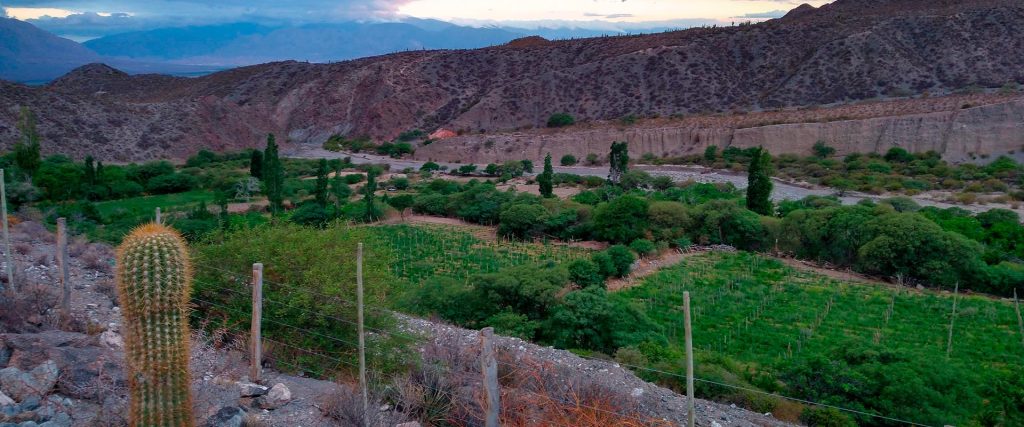When buying bulk wines from Argentina, for your business or project, it is always good to know which grape varieties are best expressed in each of the different and extensive wine regions of Argentina. Because throughout its entire geography... there is something for all tastes!
red, white, rosé, sparkling wines of the highest quality, young wines, aged wines, distillates and fortified wines.

Located in wide valleys and on sloping plains, the wine regions form a strip at the foot of the Andes Mountains that extends from north to south, in latitudes 23° to 45°. In recent years, restless producers have pushed the wine frontier westward, toward the heights, and toward the South and East, seeking the cooler temperatures of southern latitudes or the influence of the ocean.
From the high altitude vineyards of the North, through the aridity of Cuyo and the plains of Patagonia, to the new projects on the edge of the Atlantic, Argentine wines offer endless flavors that reflect the identity of each region.
* North
Jujuy, Salta, Tucumán y Catamarca
The northern valleys offer a captivating setting that fuses magical tradition with extreme altitudes.
 The North – Credits: Wines of Argentina
The North – Credits: Wines of Argentina
The climate is arid and dry, with very high average temperatures, a wide daily thermal amplitude and intense solar radiation enhanced by the altitude, and long summers. The soils are generally sandy-loam or sandy with a high proportion of fine sand that favours drainage.
The wines of the region show remarkable influence of terroir, strongly marked by altitude, and great varietal character. The Torrontés is the emblem par excellence of the region, with its characteristic perfume of Malvasia, although Malbec is the most cultivated variety with a large increase in surface area over the last 20 years.
Predominant varieties
Torrontés – Cabernet Sauvignon – Cereza – Malbec – Syrah
More info here!
* Cuyo
La Rioja, San Juan, Mendoza.
A fascinating combination of legacy and terroir in constant evolution, it is the most prolific region of South America.
 Credits: El Portal de Mendoza.
Credits: El Portal de Mendoza.
Cuyo means “desert country” in the Huarpe Millcayac language of the native peoples that inhabited this area, prior to the arrival of the colonisers. An arid and fertile region located in the center west of the country, at the foot of the Andes mountain range, which includes the provinces of La Rioja, San Juan and Mendoza.
Cuyo boasts 95% of the total area planted in the country which, added to its wine heritage and the high degree of development achieved by the industry, make it the most prolific region in South America and one of the most important worldwide. It is in Cuyo where the diverse character of Argentine viticulture becomes most evident.
The region has a semi-arid climate with scarce vegetation, cold in winter and hot in summer, enhanced by the influence of the Andes, which shows off its highest altitudes here and provides the main source of irrigation. The pure snowmelt water feeds the main rivers of the region, which are used by a system of reservoirs and channels for the irrigation of crops.
Predominant varieties
Malbec – Cabernet Sauvignon – Bonarda – Syrah – Torrontés
More info here!
* Patagonia & Región Atlántica.
La Pampa, Neuquén, Rio Negro, Chubut, Buenos Aires
A large territory flanked by low mountains and wooded areas that extends to the sea.
 Credits: Argentina.Gob.ar
Credits: Argentina.Gob.ar
The great thermal amplitude, derived from the combination of latitude and low altitude and the abundant hours of sun, are added to scarce rainfall and the strong winds that exert their influence on the crops, contributing to the health of the grapes. The climatic conditions also favour greater colour concentration in the red varieties, and the development of thicker skins.
Varieties which excel in the cold of the area reach their maximum expression here. The Merlot stands out for wines with a mild, balanced flavour with aromatic intensity. Pinot Noir is used for most of the sparkling wines, and achieves outstanding elegance in Patagonia. Although Malbec is the most cultivated variety, whites are making their mark. Sauvignon Blanc produces a superior quality wine when vigor is controlled and the grapes are harvested at full maturity, while the Chardonnay acquires a harmonious, fruity aroma with a good body.
Predominant varieties
Merlot -Chardonnay – Malbec – Cabernet Sauvignon
Más info:aquí!
A world-first Argentine initiative
Categorize the country’s wine regions
The news took the Argentine wine industry by storm and will undoubtedly have repercussions further afield: it’s the first time a country has ever carried out a study on this scale about wine regions. An initiative by Coviar, the Argentine Wine Corporation, has studied the key physical and environmental variables such as geology, soils, the climate and the landscape, of wine regions across the provinces of Mendoza, San Juan, Salta and Tucumán.
Through a reading that collects and synthesizes the complexity of wine landscapes, singularities and essences of the places with their people are revealed, values to support work based on concepts attentive to prioritizing management guidelines, to focus on the future of these landscapes.
Even more auspicious, explained those responsible for the study -financed by the IDB and presented within the framework of the Seminar on the Characterization of Wine Regions that took place at the Temple of Wine in San Martín, Mendoza, at the beginning of last September-, is that The medium-term objective seeks to replicate it throughout the country. It will be the next stage of this project, with the help of the Federal Investment Council (CFI), and will position Argentina as a world leader in wine research.
—————————————————
Lost Valley Argentina – Bulk Wine Nov 2023*
Sources:
– Wines of Argentina Regions
– Vinos y Pasiones Blog
– Wines of Argentina Blog
– Vinos y Pasiones Mapa Vitivinícola
